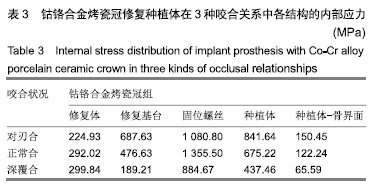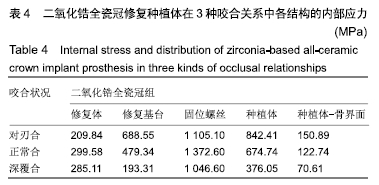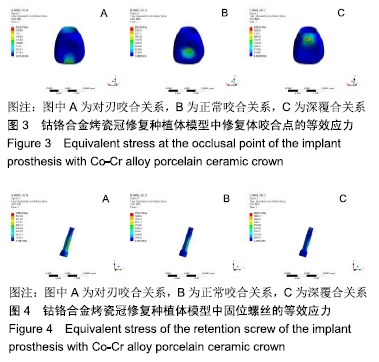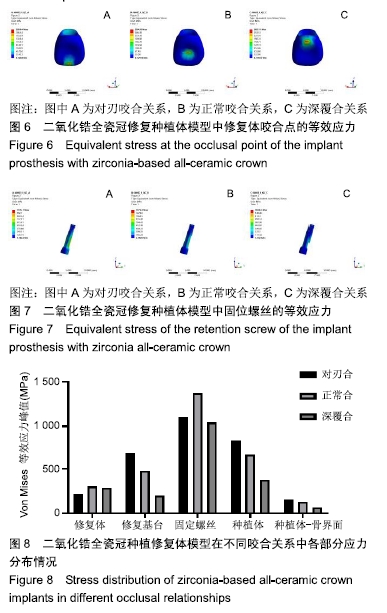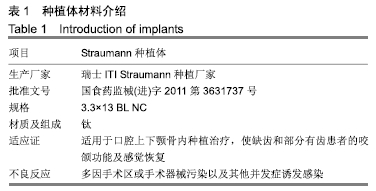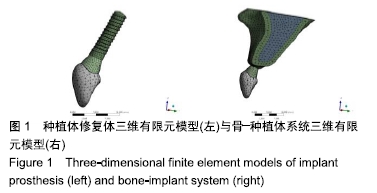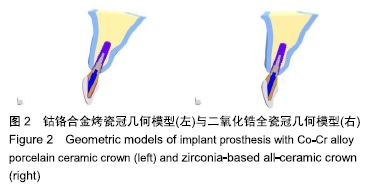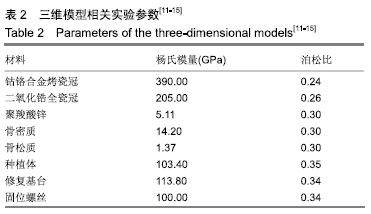[1] 张波,赵宝红.牙种植体生物力学评价研究进展[J].中国实用口腔科杂志, 2014,7(9):566-571.
[2] BRUNE A, STIESCH M.The effect of different occlusal contact situations on peri-implant bone stress - A contact finite element analysis of indirect axial loading.Mater Sci Eng C Mater Biol Appl. 2019;99:367-373.
[3] 张思佳,曾剑玉,李佳,等.三种单冠对种植体周围骨应力分布影响的光弹分析[J].中华口腔医学杂志,2018,53(1):30-35.
[4] ELFADALY LS, KHAIRALLAH LS.Peri-implant biomechanical responses to standard, short-wide, and double mini implants replacing missing molar supporting hybrid ceramic or full-metal crowns under axial and off-axial loading: an in vitro study.Int J Implant Dent. 2017;3(1):31.
[5] DAL PIVA AMO, TRIBST JPM, BORGES ALS, et al.CAD-FEA modeling and analysis of different full crown monolithic restorations. Dent Mater. 2018;34(9):1342-1350.
[6] ARINC H.Implant-Supported Fixed Partial Prostheses With Different Prosthetic Materials: A Three-Dimensional Finite Element Stress Analysis.Implant Dent.2018;27(3):303-310.
[7] PENG M, ZHAO WJ.Influence of Restorative Materials on Color of Implant-Supported Single Crowns in Esthetic Zone: A Spectrophotometric Evaluation.Biomed Res Int.2017;2017:5034358.
[8] YU SJ, SHAN WL.Effects of Four Different Crown Materials on the Peri-Implant Clinical Parameters and Composition of Peri-Implant Crevicular Fluid. J Oral Implantol.2017;43(5):337-344.
[9] ALZAREA BK.Randomized controlled clinical investigation on the association between personality profiles and the impacts of two types of maxillary anterior implant-supported crown restorations on daily living and dental satisfaction.Clin Implant Dent Relat Res. 2019;21(4):602-612.
[10] LIAO W, TANG C, WU T, et al.Design of a custom angled abutment for dental implants using computer-aided design and nonlinear finite element analysis. J Biomech.2010;43(10):1941-1946.
[11] 朱岩峰,陈伟辉,陈舟.上中切牙种植修复后3种受载应力分布的有限元分析[J].福建医科大学学报,2015,49(2):127-130.
[12] SAROT JR, CONTAR CM, CRUZ AC, et al.Evaluation of the stress distribution in CFR-PEEK dental implants by the three-dimensional finite element method.J Mater Sci Mater Med.2010;21(7):2079-2085.
[13] RAMI SM, MIRZA A, MOHAMMAD BA. Efficacy of adding a supporting implant in stress distribution of long span fixed partial dentures: a 3D finite element analysis.J Dent Res Dent Clin Dent Prospects. 2016;10(2):81-86.
[14] 雍苓,黄仕禄,刘洪,等.不同骨缺损类型牙种植体的三维有限元分析[J].医用生物力学,2016,31(2):148-153.
[15] 宁未来,杨德圣.粘接层厚度对粘接层抗力影响的有限元分析[J].现代医学, 2015,43(9):1150-1152.
[16] 张志愿.口腔颌面外科学[M].北京:人民卫生出版社,2012.
[17] BUSER D, RUSKIN J, HIGGINBOTTOM F, et al.Osseointegration of titanium implants in bone regenerated in membrane-protected defects: A histologic study in the canine mandible.Int J Oral Maxillofac Implants. 1995;10(6):666.
[18] STOICHKOV B ,KIROV D.Analysis of the cause of dental implant fracture:A retrospective clinical study.Quintessence Int. 2018; 49(4): 279-286.
[19] OLIVEIRA LA, MOREIRA MC, RIGOLDI BL, et al.The Effect of CAD/CAM Crown Material and Cement Type on Retention to Implant Abutments.J Prosthodont.2019;28(2):e552-e556.
[20] NAZARI V, GHODSI S, ALIKHASI M, et al.Fracture Strength of Three-Unit Implant Supported Fixed Partial Dentures with Excessive Crown Height Fabricated from Different Materials. J Dent (Tehran). 2016;13(6):400-406.
[21] YANG S, ZHANG K.Biological responses of preosteoblasts to particulate and ion forms of Co-Cr alloy.J Biomed Mater Res A. 2015; 103(11):3564-3571.
[22] DAL PIVA AMO, TRIBST JPM, BORGES ALS, et al.CAD-FEA modeling and analysis of different full crown monolithic restorations. Dent Mater. 2018;34(9):1342-1350.
[23] KALELI N, SARAC D, KÜLÜNK S, et al.Effect of different restorative crown and customized abutment materials on stress distribution in single implants and peripheral bone: A three-dimensional finite element analysis study.J Prosthet Dent.2018;119(3):437-445.
[24] BAGEGNI A, ABOU-AYASH S, RÜCKER G.The influence of prosthetic material on implant and prosthetic survival of implant-supported fixed complete dentures: a systematic review and meta-analysis.J Prosthodont Res.2019;63(3):251-265.
[25] SCHWEIGER J, NEUMEIER P, STIMMELMAYR M, et al. Macro-retentive replaceable veneers on crowns and fixed dental prostheses: A new approach in implant-prosthodontics.Quintessence Int.2013;44(4):341-349.
[26] KOYANO K, ESAKI D.Occlusion on oral implants: current clinical guidelines.J Oral Rehabil.2015;42(2):153-161.
[27] JOSEPH T, KARL E, RUSSELL B, et al.Immediate Loading of Tilted and Axial Posterior Implants in the Edentulous Maxillary Arch: A Retrospective Comparison of 5-Year Outcomes.Int J Oral Maxillofac Implants.2018;33(2):433-438.
[28] SHOKO M, SHIN K, SHINOBU Y, et al.Effect of finish line design on stress distribution in bilayer and monolithic zirconia crowns: a three- dimensional finite element analysis study.Eur J Oral Sci.2018;126(2): 159-165.
[29] DONG W, KEBIN T, JIANG C, et al.A Further Finite Element Stress Analysis of Angled Abutments for an Implant Placed in the Anterior Maxilla.Comput Math Methods Med.2015;2015:1-9.
[30] MERIN RL.Repair of peri-implant bone loss after occlusal adjustment: A case report. J Am Dent Assoc.2014;145(10):1058-1062.
[31] 陈小璇,刘国强,徐昕.上颌中切牙角度基台不同载荷的三维有限元优化分析[J].中国组织工程研究,2015,19(38):6200-6204.
[32] 肖严,熊康,权菲菲.不同咬合状态下上颌中切牙全瓷冠修复的有限元分析[J].中国组织工程研究,2016,20(12):1806-1811.
[33] ARINC H.Implant-Supported Fixed Partial Prostheses With Different Prosthetic Materials: A Three-Dimensional Finite Element Stress Analysis. Implant Dent.2018;27(3):303-310.
[34] BAGEGNIA A, ABOU-AYASH S.The influence of prosthetic material on implant and prosthetic survivalof implant-supported fixed complete dentures: a systematic review and meta-analysis. J prosthodont Res. 2019;63(3):251-265.
[35] CHAE SW, KIM YS, LEE YM, et al.Complication incidence of two implant systems up to six years: a comparison between internal and external connection implants.J Periodontal Implant Sci.2015;45(1):23-29.
[36] THYMI M, VISSCHER CM, YOSHIDA-KOHNO E, et al.Associations between sleep bruxism and peri-implant complications: a prospective cohort study.BDJ Open.2017;3:17003.
[37] CHENG CW, CHIEN CH, CHEN CJ, et al.Randomized Controlled Clinical Trial to Compare Posterior Implant-Supported Modified Monolithic Zirconia and Metal-Ceramic Single Crowns: One-Year Results.J Prosthodont.2019;28(1):15-21.
[38] YI Y, KOAK JY, KIM SK, et al.Comparison of implant component fractures in external and internal type: A 12-year retrospective study.J Adv Prosthodont.2018;10(2):155-162.
[39] KOURTIS S, DAMANAKI M, KAITATZIDOU S, et al.Loosening of the fixing screw in single implant crowns: predisposing factors, prevention and treatment options.J Esthet Restor Dent.2017;29(4):233-246.
[40] EMRE OS, MUTLUAY US, EMEL Y, et al.Effects of crown retrieval on implants and the surrounding bone: a finite element analysis.J Adv Prosthodont.2016;8(2):131-136.
[41] ÜLKÜ SZ, ACUN KAYA F, UYSAL E, et al.Clinical Evaluation of Complications in Implant-Supported Dentures: A 4-Year Retrospective Study.Med Sci Monit.2017;23:6137-6143.
[42] SHERIDAN RA, DECKER AM, PLONKA AB, et al.The Role of Occlusion in Implant Therapy: A Comprehensive Updated Review. Implant Dent. 2016;25(6):829-838.
|

